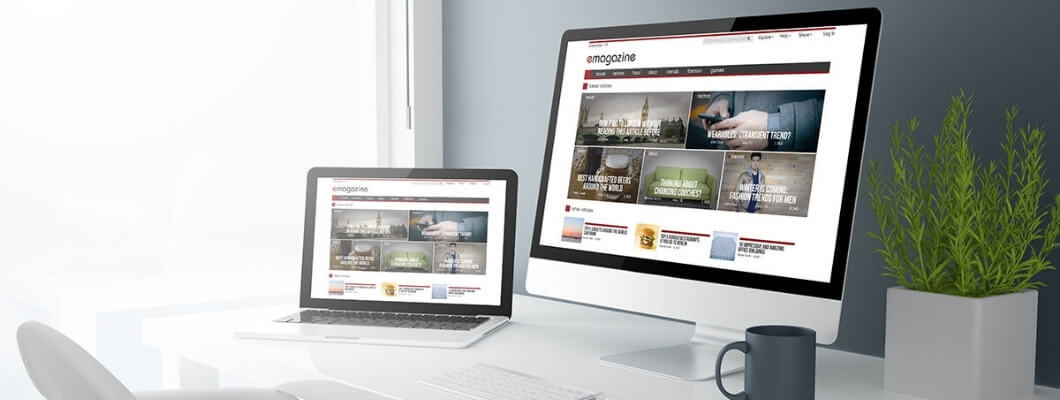
Başarılı Bir Blog İçin Web Tasarımı İpuçları
Başarılı bir blog oluşturmak ve yönetmek, etkili içerik üretiminin yanı sıra kullanıcı dostu bir web tasarımı gerektirir. Blogunuzun tasarımı, ziyaretçilerinizin siteyi nasıl algıladığını ve sitede ne kadar süre kaldığını doğrudan etkiler. Bu makalede, başarılı bir blog için web tasarımı ipuçları sunarak, hem görsel açıdan çekici hem de SEO dostu bir tasarım oluşturmanıza yardımcı olacağız.
Web Tasarımında Blog Başarısının Önemi
Bir blogun başarısında tasarımın rolü büyüktür. İlk izlenimler genellikle tasarım üzerinden oluşur ve kötü bir tasarım, en iyi içeriklere bile gölge düşürebilir. Kullanıcılar, kolay gezinim sağlayan, hızlı yüklenen ve estetik bir blogda daha fazla vakit geçirir. Bu yüzden web tasarımında doğru stratejilerle ilerlemek, blogunuzun hem kullanıcı deneyimini hem de arama motoru sıralamalarını yükseltebilir.
Başarılı Bir Blog İçin Web Tasarımı İpuçları
SEO Dostu Bir Tema Seçimi
Blog tasarımınıza başlamadan önce, SEO uyumlu bir tema seçmek önemlidir. SEO dostu temalar, hızlı yükleme süreleri, mobil uyumluluk ve temiz kod yapısı gibi özelliklere sahiptir. Bu temalar, Google gibi arama motorlarının blogunuzu daha kolay anlamasını ve sıralamasını sağlar.
Mobil Uyumluluğa Öncelik Verin
Günümüzde internet kullanıcılarının büyük bir bölümü mobil cihazlar üzerinden web sitelerine erişiyor. Bu nedenle, blogunuzun tasarımının mobil cihazlarla uyumlu olması bir zorunluluktur. Mobil uyumlu tasarımlar, ziyaretçilerinize her cihazdan sorunsuz bir deneyim sunar ve Google'ın sıralama kriterlerine uygundur.
Hızlı Yükleme Süresi Sağlayın
Web sitenizin yükleme hızı, kullanıcı deneyimi ve SEO açısından kritik öneme sahiptir. Yavaş yüklenen bir site, ziyaretçilerinizi kaybetmenize neden olabilir. Hızlı bir blog tasarımı için şu adımları uygulayabilirsiniz:
- Görselleri sıkıştırarak daha küçük boyutlarda yükleyin.
- Gelişmiş önbellekleme araçları kullanın.
- Minimalist bir tasarımı tercih ederek gereksiz kodlardan kaçının.
Net ve Kullanıcı Dostu Navigasyon
Blogunuzun menü yapısı, kullanıcıların aradıkları bilgilere kolayca ulaşmasını sağlamalıdır. Karmaşık ve dağınık bir navigasyon sistemi, kullanıcıların sitenizde gezinmesini zorlaştırır. Ana menüde kategorilere ayrılmış net bir yapı oluşturun ve alt menüleri gerektiğinde kullanın.
Görsel ve İçerik Dengesi
Blogunuzda hem metinlerin hem de görsellerin dengeli bir şekilde yer alması, kullanıcıların dikkatini çekmek için önemlidir. Ancak, fazla görsel kullanımı da site hızını olumsuz etkileyebilir. Görsellerinizi optimize ederek yüksek kalitede, ancak düşük boyutlu dosyalar kullanmayı tercih edin.
SEO ve Kullanıcı Deneyimi İçin İpuçları
Anahtar Kelime Optimizasyonu
Her blog yazınızda, doğru anahtar kelimeleri stratejik noktalara yerleştirerek arama motoru optimizasyonunu artırabilirsiniz. Başlık, meta açıklama, alt başlıklar ve görsel alt metinlerinde anahtar kelimelerinizi kullanmayı unutmayın.
İç Bağlantılar (Internal Links)
Blogunuzda iç bağlantılar kullanarak ziyaretçileri ilgili içeriklere yönlendirebilirsiniz. Örneğin, "Başarılı bir blog için içerik stratejileri" başlıklı başka bir yazınız varsa, bu yazıya bağlantı eklemek hem kullanıcı deneyimini hem de SEO'yu geliştirebilir.
Okunabilirlik ve Tasarım Uyumu
Ziyaretçiler, karışık ve okunması zor bir tasarıma sahip sitelerden hızla uzaklaşır. Blog tasarımında okunabilirliği artırmak için şu unsurlara dikkat edin:
- Yeterli beyaz alan bırakın.
- Yazı tipini kolay okunabilir bir boyutta ve tarzda seçin.
- Kontrast renkler kullanarak metni daha görünür hale getirin.
- Web Tasarımında Teknik Detaylara Dikkat Edin
SSL Sertifikası Kullanımı
Güvenli bir siteye sahip olmak, kullanıcıların bilgilerinin korunması açısından önemlidir. Ayrıca, HTTPS protokolüne sahip bloglar, arama motorlarında daha üst sıralarda yer alabilir.
404 Hatalarını En Aza İndirin
Bozuk bağlantılar ve 404 hataları, kullanıcı deneyimini olumsuz etkiler. Blogunuzda düzenli kontroller yaparak bu tür hataları tespit edin ve yönlendirmeler oluşturun.
Görsel Alt Metinleri ve Etiketleri Kullanın
Görsellerinizi açıklayıcı alt metinlerle desteklemek, SEO açısından avantaj sağlar. Arama motorları, görsellerin ne hakkında olduğunu anlamak için alt metinleri kullanır.
Başarılı Bir Blog İçin Web Tasarımı Stratejileri
Etkili Çağrı Butonları (CTA)
Ziyaretçilerinizi belirli bir eylemi gerçekleştirmeye yönlendirmek için dikkat çekici ve net çağrı butonları ekleyin. Örneğin, "Daha Fazla Oku", "Üye Ol" gibi ifadelerle kullanıcıları harekete geçirebilirsiniz.
Sosyal Medya Entegrasyonu
Blogunuzun sosyal medya entegrasyonuna sahip olması, içeriğinizin daha fazla kişiye ulaşmasını sağlar. Paylaşım butonları ekleyerek kullanıcıların içeriğinizi sosyal platformlarda paylaşmasını kolaylaştırabilirsiniz.
Sıkça Sorulan Sorular
Başarılı bir blog tasarımı için en önemli özellik nedir?
- Mobil uyumluluk, hızlı yükleme süresi ve kullanıcı dostu bir navigasyon başarılı bir blog tasarımının temel özellikleridir.
SEO dostu bir tema nasıl seçilir?
- Hızlı yükleme süreleri, mobil uyumluluk ve temiz kod yapısına sahip temalar SEO dostudur.
Mobil uyumluluk neden önemlidir?
- Çoğu kullanıcı mobil cihazlardan bloglara erişir, bu nedenle mobil uyumluluk kullanıcı deneyimini ve SEO'yu artırır.
Web sitesi yükleme hızını nasıl artırabilirim?
- Görselleri optimize edin, önbellekleme araçları kullanın ve minimalist bir tasarım tercih edin.
Blogda görsel kullanımında nelere dikkat edilmeli?
- Görseller optimize edilmeli, yüksek kalite sağlanmalı ancak düşük boyutlu olmalıdır.
İç bağlantılar neden önemlidir?
- Ziyaretçilerin ilgili içeriklere yönlendirilmesini sağlar ve SEO’yu iyileştirir.
Blog tasarımında okunabilirliği nasıl artırabilirim?
- Beyaz alan bırakın, okunabilir yazı tipleri kullanın ve kontrast renkler seçin.
SSL sertifikası kullanımı zorunlu mu?
- Güvenlik ve arama motoru sıralamaları için SSL sertifikası büyük önem taşır.
404 hatalarını nasıl engellerim?
- Düzenli kontroller yaparak bozuk bağlantıları düzeltin ve uygun yönlendirmeler oluşturun.
Sosyal medya entegrasyonu blogum için gerekli mi?
- Evet, sosyal medya entegrasyonu içeriğinizi daha geniş bir kitleye ulaştırmanıza yardımcı olur.






Yorum Yapın